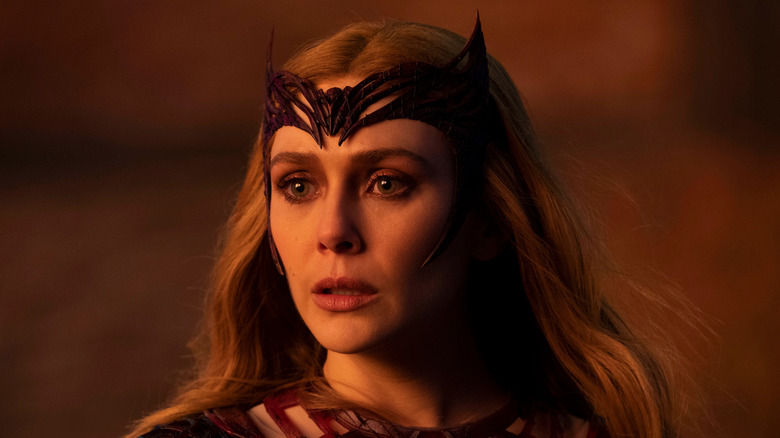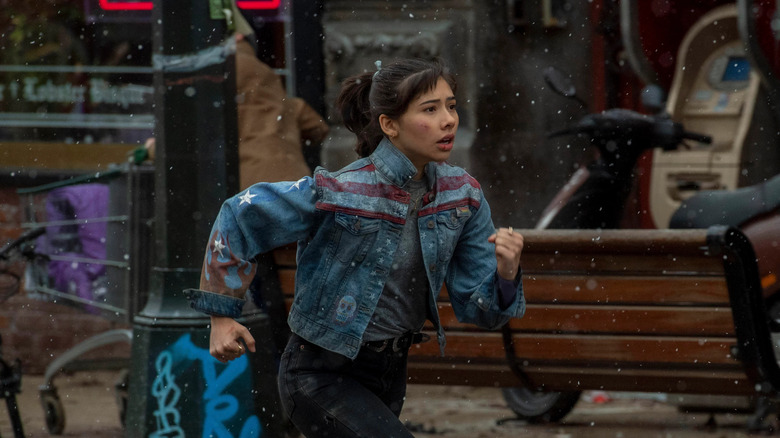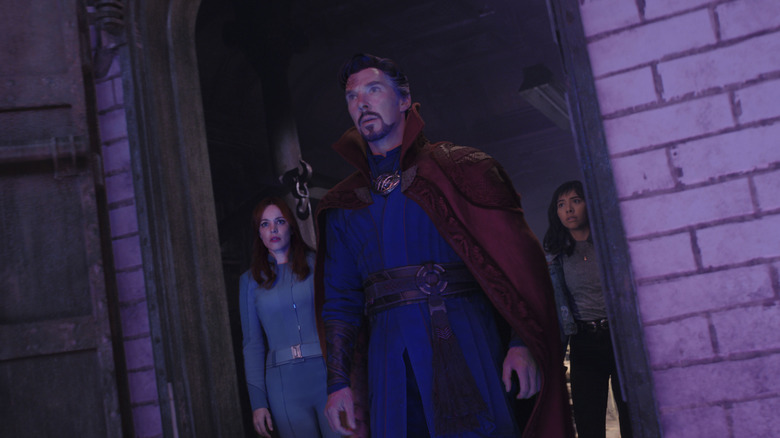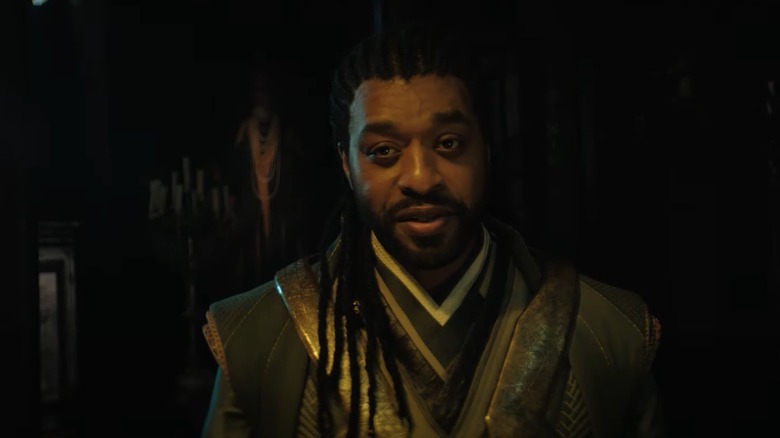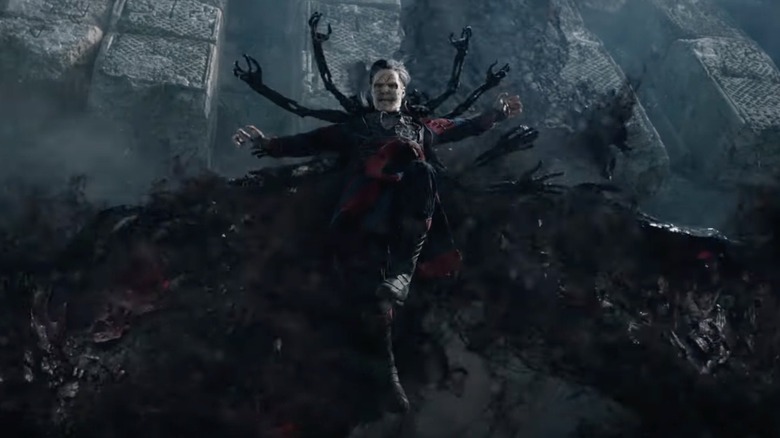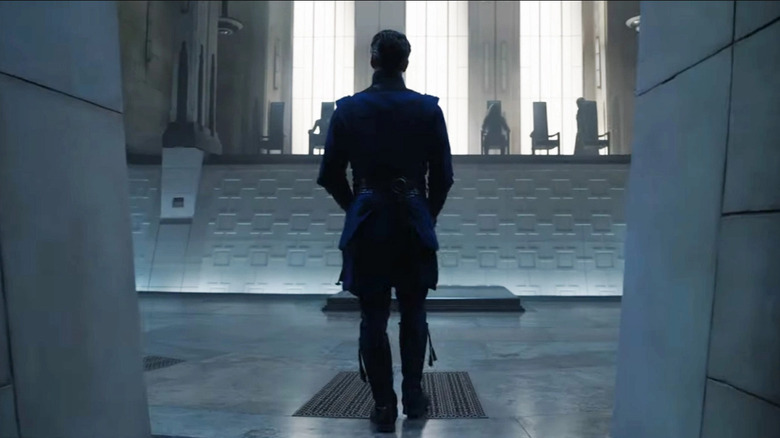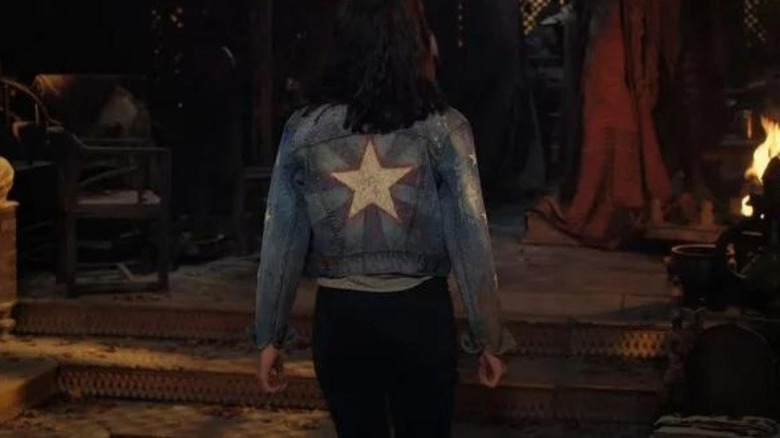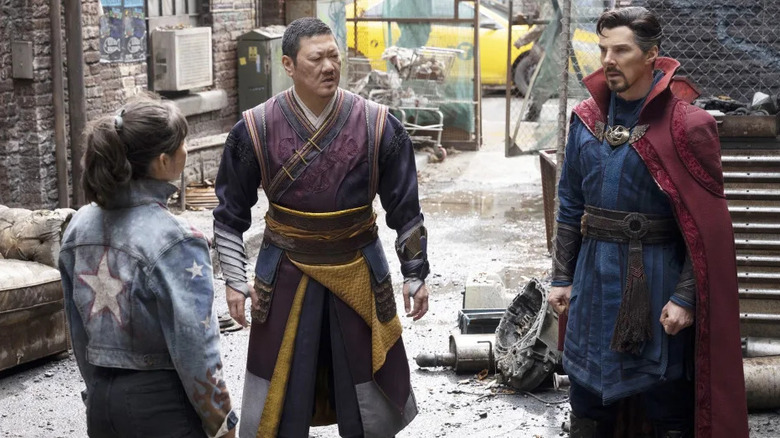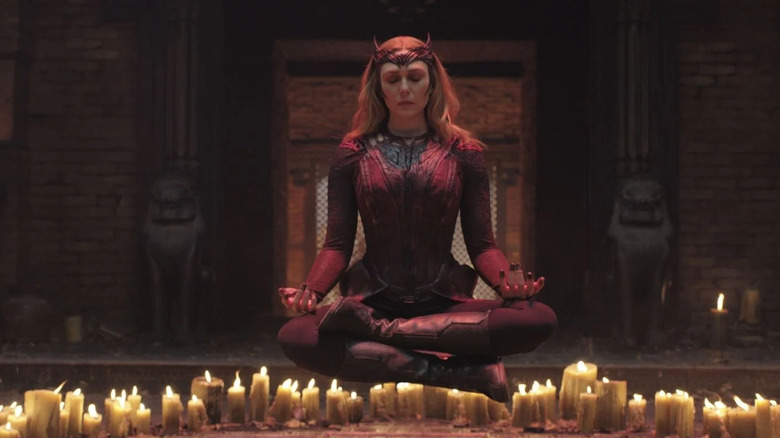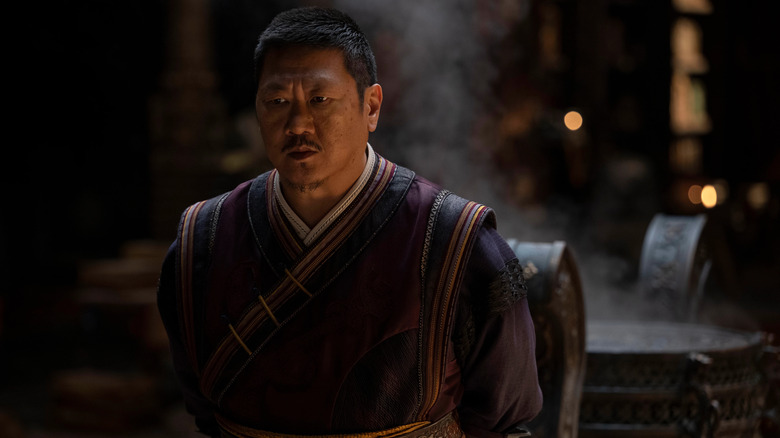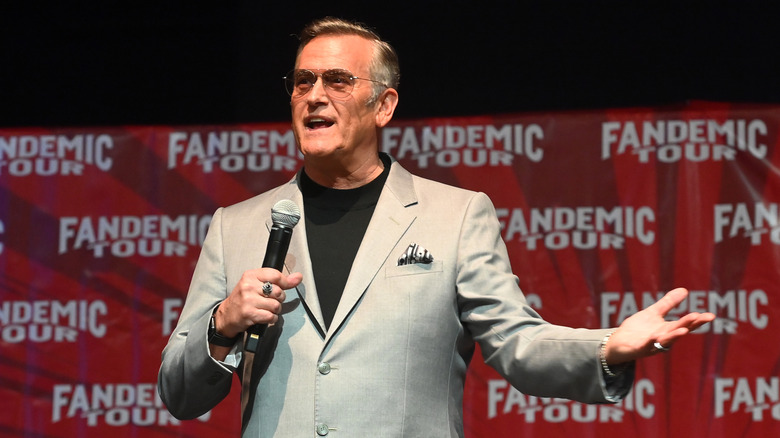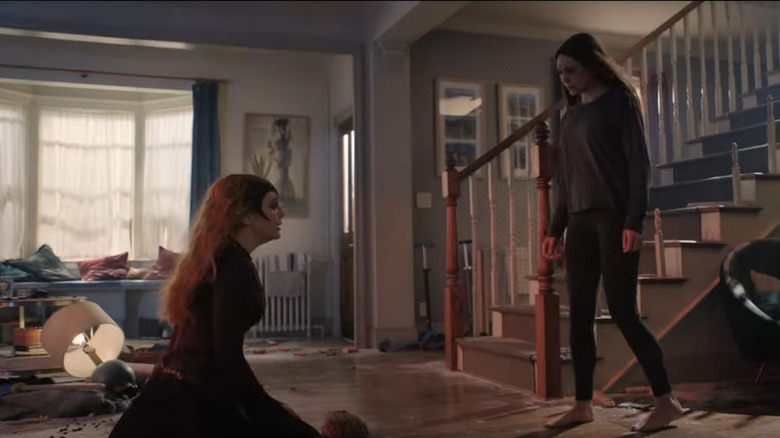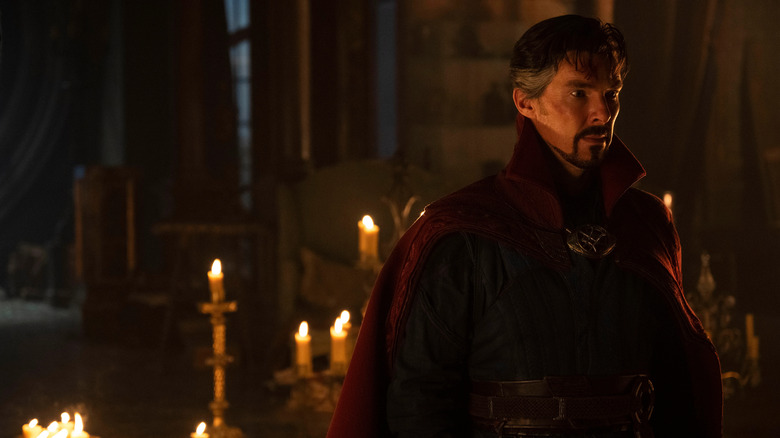The 6 Best And 6 Worst Things In Doctor Strange In The Multiverse Of Madness
Even by Marvel Cinematic Universe standards, "Doctor Strange in the Multiverse of Madness" is packed with big ideas, big developments, and lots of details both large and small to chew over after the final post-credits scene has rolled. Benedict Cumberbatch's Master of the Mystic Arts finds him facing not just a new magical threat, but a multiverse full of new mysteries and possible dangers, and that means the film has to pack in not just pre-existing characters, but new people, new places, and new plot developments to keep the MCU engine moving.
The film, directed by Sam Raimi from a script by Michael Waldron, largely works pretty well, maneuvering the big pieces necessary into place to craft a satisfying superhero story with an emotional core. But there are a few missteps along the way, including some that work in tandem with the most satisfying pieces of the film. Now, it's time to break it all down. Here are the six best and six worst things about "Doctor Strange in the Multiverse of Madness."
SPOILERS AHEAD for the entire film.
Worst: America's characterization
"Doctor Strange in the Multiverse of Madness" introduced a key new character to the Marvel Cinematic Universe in the form of America Chavez, a gifted young woman played by Xochitl Gomez. America's role in the story is essentially that of a living MacGuffin, since her ability to punch open portals between universes makes her a valuable asset to the Scarlet Witch. With that in mind, America spends much of the film on the run, struggling to control her power while also struggling to escape Scarlet Witch.
There's nothing necessarily wrong with the character, and Gomez is definitely a charming, capable actress with a lot to contribute to the wider MCU. If you've read America's comic book appearances, though, particularly in recent years, you know that she's a character with considerably more swagger and confidence than she gets in the film. The comics version of America would be much more likely to fight back, and while we can dismiss the difference as the need to portray the MCU version as a superhero beginner, it still comes across as a little jarring. Hopefully future appearances for the character will give her a little more of her comic book personality.
Best: Sam Raimi's visual style
"Doctor Strange in the Multiverse of Madness" is the first superhero film in more than a decade to be directed by Sam Raimi, the energetic filmmaker behind the original "Spider-Man" trilogy and a lifelong comic book fan whose exuberance for the genre seeps through onto the screen. Raimi's involvement was reason enough for even non-MCU fans to get excited about the new film, and it was clear even from the opening sequence that Raimi came to play.
Though there's been no shortage of interesting filmmakers working in the MCU over the years, "Multiverse of Madness" just might be the most visually exciting film Marvel Studios has released in at least half a decade. It might not be able to match the scale of something like "Avengers: Endgame" or the comic chops of a "Thor: Ragnarok," but the sheer force of Raimi's visual creativity sets it apart from other films in this franchise. It's a movie we're going to be looking at shot-by-shot for years to come.
Worst: An odd use of Mordo
One of the more intriguing supporting characters confirmed early on for "Doctor Strange in the Multiverse of Madness" was Karl Mordo, Stephen Strange's teacher turned rival sorcerer played by Chiwetel Ejiofor. The character had not been seen since his turn to the darker side of things at the end of the first "Doctor Strange" movie, so his appearance in the sequel (for the first time in six years) seemed to suggest we'd get a chance to see what he's been up to since.
Sadly, the version of Mordo that we see in "Multiverse of Madness" is actually a version of the character from an alternate universe, and while he's antagonistic toward Strange, he's not the same kind of antagonist we were expecting from the post-credits scene in the original film. The film doesn't have the time or space to give us the original flavor of Mordo, and then when it gives us a fight between the two sorcerers, the alternate reality Mordo ends up strapped in a shallow trench, shouting at Strange rather than fighting on. Ejiofor is, as always, up to whatever acting task he's given, but it felt like an underwhelming return for an interesting character.
Best: The horror
From the moment "Multiverse of Madness" was announced, Marvel Studios head and producer Kevin Feige promised the film would integrate horror elements in the Marvel Cinematic Universe in ways we'd never seen before. Now that the film is here, it's clear that he made good on that promise.
The first "Doctor Strange" film, directed by "Sinister" helmer Scott Derrickson, certainly featured its share of creepy elements, but "Multiverse of Madness" pushes all of that just a little further. It begins with the decision to make the Scarlet Witch into a full-on movie monster, complete with jump scares and creepy body movements, and continues on into the film's wild finale, which features Doctor Strange possessing his own corpse from another universe and creating a flying cloak out of the souls of the damned. It's not the scariest movie you're ever going to see, but for a superhero film in one of the most mass-appeal-based franchises ever, it's definitely packing more than a few frightening moments, which is rather refreshing.
Worst: The fan service
Fan service is an inevitable part of the Marvel Cinematic Universe, and there's nothing wrong with that. Whether we're talking about the days of the earliest Stan Lee cameos or the merging of three different Spider-Man timelines into one movie experience, there's real value in getting audiences excited about familiar things they can cheer about. That said, there's a point where it runs out of steam, and "Doctor Strange in the Multiverse of Madness" ultimately hits that point.
The scene in which Stephen Strange meets the superhero group "The Illuminati" from another universe is packed with fan service and big, cheer-worthy cameos. Unfortunately, despite its importance to the film's overall plot, it sometimes plays more like a roll call than an actual piece of dialogue between various major characters. By the time all the characters pause their arguing to allow Charles Xavier to dramatically roll in from the other room, it's clear that the scene's first priority is packing in the cameos, and while that's fun, it's also clumsy. There had to be a smoother way to pull all of this off.
Best: Also the fan service
Longtime Marvel Cinematic Universe viewers are used to fan service at this point. The people behind these films know that their fans are watching them as much for the substantive narrative as for the Easter eggs, cameos, and hints of things to come, and so they're obviously ready to pack as much of that content as possible into each film. And yes, that can get tiresome sometimes, and in "Doctor Strange in the Multiverse of Madness," there are moments when it feels like it honestly does.
But even with that in mind, it's hard to deny the raw endorphin buzz that many of these moments are able to generate when they roll out just right. Sure, some of it can feel excessive, but hearing "The smartest man in the world, Reed Richards of the Fantastic Four" is enough to send a chill down your spine, even if it is a payoff of years of internet fancasting more than an actual character moment. Plus, no matter how you feel about his present or future involvement in the MCU, hearing the "X-Men: The Animated Series" worked into Charles Xavier's introduction is one of the coolest flourishes the MCU has ever pulled off. So yes, fan service can be rough, but it can also still work really well.
Worst: Strange pacing decisions
Superhero movies are not, and have never been, exercises in 100% realism, and we don't just mean in terms of people flying around shooting energy out of their hands. There's a sense of heightened reality to every aspect of these films, which means you have to suspend your disbelief a little bit when someone needs to make a rousing speech or take a moment in the middle of a big fight to have an outburst of emotion. It's just part of the game. That said, there are times when that suspension of disbelief is tested, and "Doctor Strange in the Multiverse of Madness" has a few of them that stand out.
Many issues can be traced to seemingly small character decisions that end up being really noticeable. The film sets the Scarlet Witch up as this unstoppable force of terror, then shows us characters who are waiting behind doors they already know she can break through, as though they're suddenly safe. It gives us characters who've just seen how hard they need to fight to survive moving far too slowly, attacking Wanda one at a time. And it even pauses for a moment of high drama when Strange finally gets to the Book of Vishanti, when the narrative has already proven there's no time to waste. Again, these are small moments, but in an otherwise well-paced film, they really stand out.
Best: Elizabeth Olsen
Elizabeth Olsen has always been a formidable actor, and it sticking around the MCU so long has given her the opportunity to show off just how much emotional weight she can add to a superhero story. We saw it most prominently with her show "WandaVision," but she doesn't let any of that power lapse by the time "Multiverse of Madness" rolls around. If anything, she deepens and darkens it.
This time around, Olsen gets to play not just Wanda -– a frightened, traumatized, sad woman just trying to make it through the day -– but also Scarlet Witch, a determined and relentless magic user who is convinced she's doing the right thing even when slaughtering innocent people. Olsen's ability to pivot between those performances on a dime, and in some scenes even play both of them at the same time, is one of the film's greatest assets. She's capable of being both deeply vulnerable and flat-out terrifying, which deepens the emotion behind the entire film's arc, and makes us hope she gets to stick around for more adventures.
Worst: Not enough Wong
The Marvel Cinematic Universe is packed with characters, and the finite runtime of movies means that some of those characters are going to fall by the wayside over the course of certain adventures. "Multiverse of Madness" is a Doctor Strange movie, but it also has to make room for plenty of screentime for the Scarlet Witch, alternate versions of Doctor Strange, American Chavez, and more. That means other characters get pushed to the back more than they should, and unfortunately, Wong is a victim of that in this film, to its detriment.
Played by Benedict Wong, Wong is one of the great supporting characters in the entire MCU. He's charming, he's funny, he has great chemistry with Stephen Strange, and the universe has rewarded him by making him the current Sorcerer Supreme and key part of the magical corner of this overarching story. And yet, despite a few scene-stealing moments, Wong spends a huge chunk of the film either in silent captivity or knocked unconscious, waiting for the opportune time to show up and help save the day. Again, there's only so much time to give each character in a movie, but Wong feels like he got short shrift. Hopefully future films can rectify that.
Best: Bruce Campbell
Any longtime fan of Sam Raimi knows that the director has certain hallmarks. There's the mixing of humor and horror, the clever transition work, the dynamic moving camera, and of course, the involvement of Bruce Campbell. Since coming up in the film business with Raimi and starring in the director's breakthrough film, "The Evil Dead," Campbell has continued to make cameo appearances of various sizes throughout the Raimi filmography. When Raimi was confirmed to make "Doctor Strange in the Multiverse of Madness," fans hoped they'd see Campbell pop up, and we weren't disappointed.
It takes a little while for Campbell's cameo to take shape, but Raimi makes it count, casting his old friend as the unsuspecting, gruff owner of a pizza ball stand in an alternate universe who demands America Chavez pay for her food. Doctor Strange intervenes and casts a spell on the man that makes him beat himself for a period of three weeks. It's a great physical comedy showcase for Campbell, and it pays off one more time in the film's post-credits scene. It's a small part of the film, but always a delight when Campbell gets some screen time.
Worst: Wanda's ambiguous fate
The key dramatic push-pull of "Doctor Strange in the Multiverse of Madness" falls on the continuing saga of Wanda Maximoff, the star of "WandaVision" who's still having a hard time dealing with the fallout from the events of that series. Wanda, despite her growth and knowledge, still misses her family deeply, and all the time she's spent studying the Darkhold has turned into a full-on yearning for change. She emerges as the key antagonist of the film when it's clear that the Scarlet Witch persona has overtaken her more reasonable side, and that she's willing to get an alternate version of her kids to be with her, no matter the cost.
By the end of the film, of course, Wanda is able to see the error of her ways, and realizes that the pursuit of her children has made her a monster. She decides to destroy the Darkhold in all its forms, and in the process brings a mountain temple down around herself, seemingly killing her. Of course, anyone who follows comic book storytelling knows that this probably isn't actually the end for Wanda, so why make it ambiguous at all? Why not just show us Wanda Maximoff either truly dying in an act of sacrifice, or going off into seclusion again to find her way in the world anew? It feels more like a setup than an honest ending to a satisfying arc, and that's a shame.
Best: Emotional Stakes
The Marvel Cinematic Universe is an increasingly vast landscape of characters, locations, situations and conflicts, which means sometimes the stories can get so bogged down in keeping up with continuity that they have a hard time establishing any real emotional resonance. Yes, it's cool to spend an entire film talking about various superheroes, but at a certain point, you still want to be reminded why you care about them as people.
"Doctor Strange in the Multiverse of Madness" certainly has its share of major exposition, but writer Michael Waldron takes all the talent he displayed writing the Disney+ series "Loki" and pours it into the characters along the way. We understand why Wanda Maximoff is still struggling so much, and why she's willing to give into the power of the Scarlet Witch. We understand why Stephen Strange is at an emotional crossroads in his life, and has difficulty being truly happy despite his immense power and influence. We even understand, thanks to one particularly important piece of backstory, why Strange is such a control freak to begin with, and why he has a hard time forming attachments with people. It's an effectively structured, well-paced story that knows exactly when to let the heart shine through.
